13 Cheddar Cheese Substitutes For Cooking, Ranked
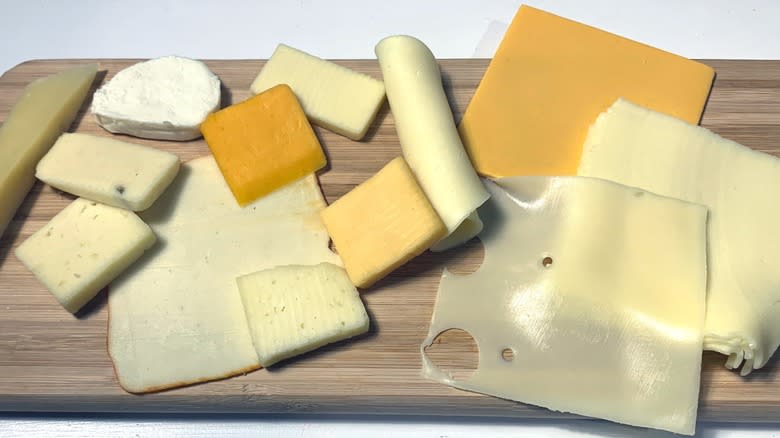
Cheddar cheese has a long and rich history. First appearing in the town of Cheddar, England in the 12th century, this cheese grew in popularity throughout the world. By the middle of the 19th century, cheddar was the most popular cheese in the U.S.
What defines cheddar cheese varies. In the U.S., the FDA governs the definition of cheeses, and it says that if a variety contains no more than 50% milkfat and no more than 39% moisture, it's cheddar. Everything else is at the discretion of the manufacturer, including the age, type of milk used, or production methods. That's a loose definition. How cheddar tastes often relies on two factors: age and location. The longer it is aged, the sharper it will be. For example, Wisconsin cheddar has a sweeter flavor, while New England cheddar is more bitter and sharp.
Cheddar cheese is still one of the most popular types of cheese for cooking. Whether you're making a grilled cheese sandwich, creating a homemade mac and cheese casserole, or just topping off a recipe, cheddar is robust and versatile. But it's not the final word on cheese. Many varieties can replace it and liven up mundane recipes. These are the top substitutes for cheddar cheese.
Read more: 13 Unexpected Ingredients To Elevate Lasagna
Mozzarella
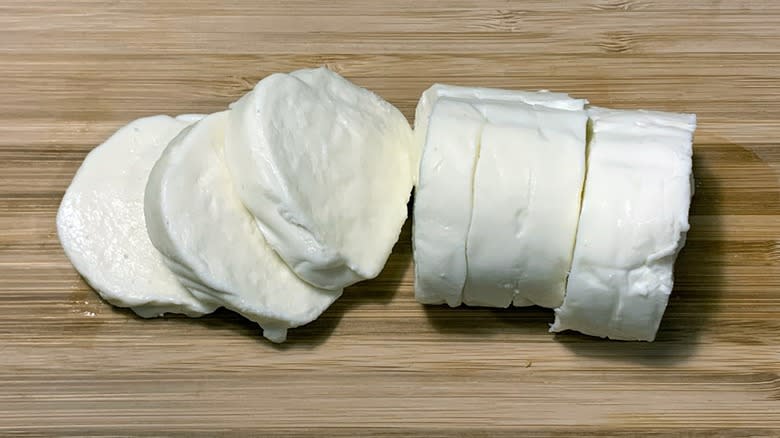
Like cheddar, mozzarella originated in the 12th century, this time in southern Italy. The stretching and kneading process that makes this cheese gives it a firm yet stringy consistency. That explains why it took the longest to melt and why it is a perfect topping for pizza.
Mozzarella comes in a few varieties, including mozzarella di bufala, derived from buffalo milk. However, the brand we chose comes from cow milk. Unlike cheddar, it's white in color and semi-soft, with a very mild yet distinctive flavor that does not mimic the sharpness of cheddar.
We would not always recommend mozzarella to replace cheddar. For example, it will work for mac and cheese or any dish that is flavored by a sharp cheese. However, it's an excellent sandwich and flatbread topper. It works if you want to lend your recipe an Italian flair by adding pesto or tomato sauce. Mozzarella is a great cheese to blend with sharper cheeses, like cheddar, in dishes such as quiche.
Provolone
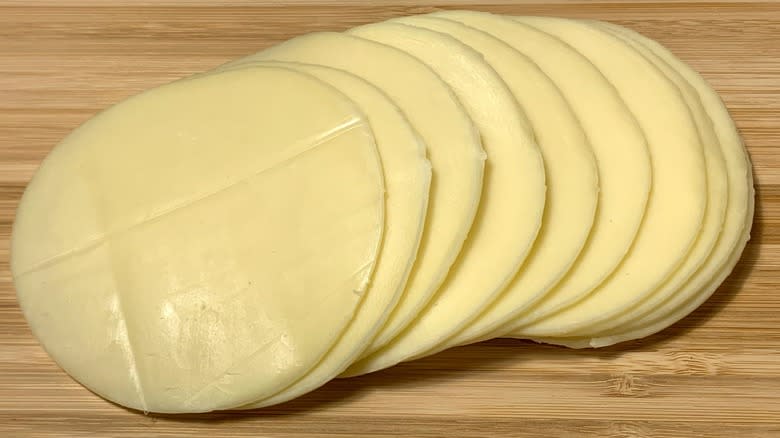
Next on our list is another Italian cheese, provolone, available in different varieties. It only dates back to the 19th century, also in southern Italy. Like mozzarella, the provolone-making process requires stretching. Provolone comes in a variety of styles and has a generally smoky flavor. The mild dolce requires two months of aging, while provolone picante needs at least four. This sharper version is firmer, too, so if you want a cheese that melts, dolce is your best choice.
Provolone is mild but has a flavor that is distinct from cheddar. It took more time to melt than other cheeses and quickly burnt on the bottom, so exercise caution when melting. However, the process made the cheese milder in taste, making it a better fit to replace cheddar taste-wise. We still would not use it for mac and cheese, omelets, or cheddar soup recipes. Provolone is a wonderful choice for sandwiches, paninis, and salads. You can also add it to vegetables such as cauliflower, tomatoes, and carrots.
We also love adding aged provolone to our charcuterie boards, especially alongside cheddar and cured Italian meats. To impress your guests, serve it with salami, prosciutto, soppressata, pickled red peppers, and crostini.
Swiss Cheese
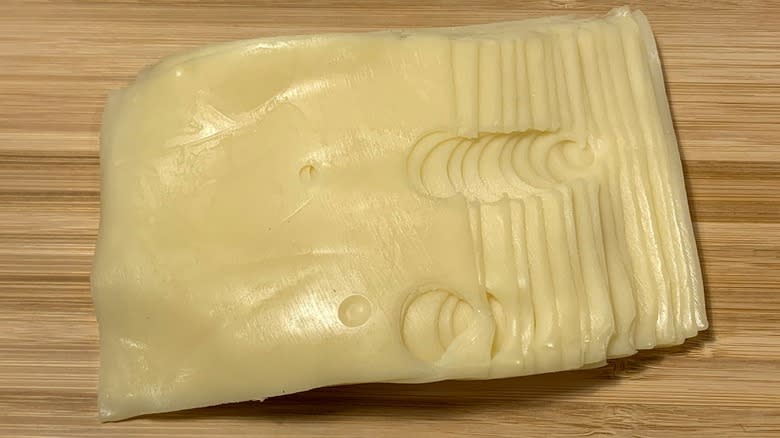
Swiss cheese is easily recognizable because of its visible air holes. It hails from Emmental Valley in Switzerland and dates back to the 14th century. There are many varieties of Swiss cheese, but the Emmental variety is the one we think of most commonly in the U.S., outside of Gruyère.
Those distinctive air holes look like mouse nibbles -- and you can find many cartoons that illustrate this. The bacteria in the cheese release carbon dioxide once thought to cause the holes. However, new research shows that initially, hay got into the cheese, creating air pockets. As hygienic cheese production methods came into practice, the holes got smaller. In Switzerland, high altitudes and longer aging times create a sharper cheese. In the U.S., modern manufacturing replaces traditional aging and is limited to four months, creating a milder flavor.
Swiss is a good choice because of its availability, but the flavor differs from cheddar. It melts well but retains the flavor, so it's not a good one-for-one substitute, but it's great for sandwiches and salads. If you're melting it on a burger, steak sauce complements the flavor better than ketchup. You can use Swiss cheese in au gratin dishes, and it makes a great fondue choice. It is a perfect fit for quiche, too, but it won't work for mac and cheese or cheese-based soups. A nice solid block of Swiss fits well with charcuterie, paired with grapes and apple slices, and provides a good counterbalance with cheddar.
Gruyère
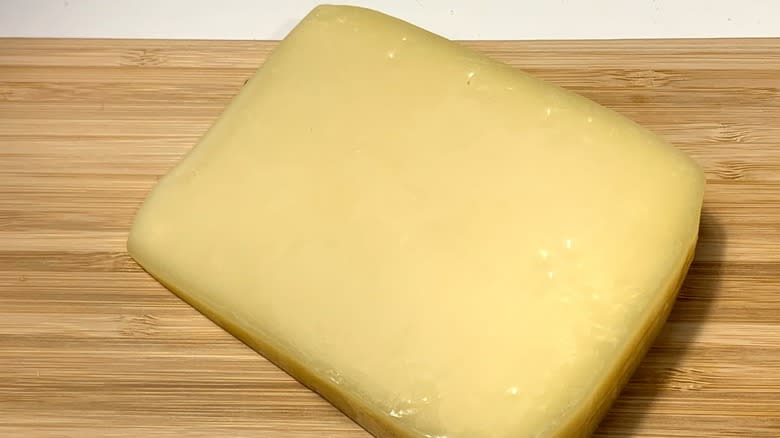
Gruyère is another cheese from a different region of Switzerland, the town of the town of Gruyères. Most commonly found atop French onion soup, gruyère is similar in flavor to Swiss but richer and softer, making it a better choice to replace cheddar. It is not, however, a sharp cheese, so keep that in mind.
Known for its creaminess, you'll need to use caution when selecting Gruyère as a sub for cheddar to ensure that it fits the recipe. It's also excellent for whipping up a milder cream sauce to top savory dishes.
This cheese is soft and mild, often a good choice for melting. We did not like the melting texture of the brand we chose, so be selective at the store. Use it to whip up an exceptionally creamy quiche. Gruyère is also a good choice for quiche, au gratin dishes, potato recipes, and recipes with strong-flavored meats like sausage.
Pepper Jack
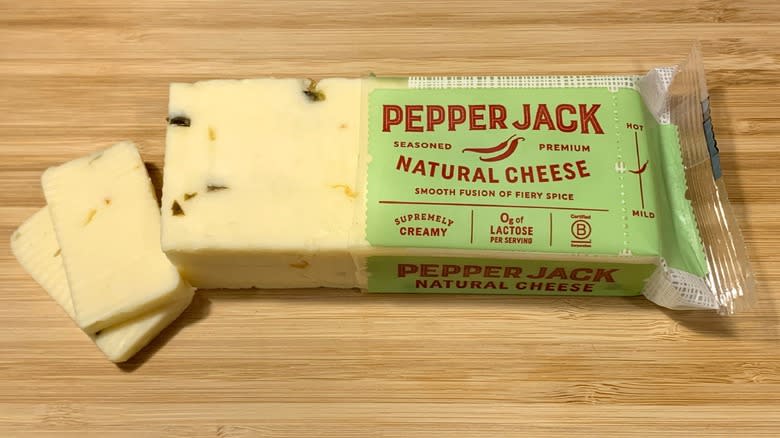
Pepper Jack is only a good choice if you like a bit of heat in your dish. Some people disagree, claiming its smoky flavor will ruin cheddar dishes. Therefore, we advise you to choose your recipes wisely when substituting. This cheese consists of Monterey Jack with jalapeños and red bell peppers for that spicy kick. It may also contain garlic, rosemary, sweet peppers, and habanero peppers. Read your package before purchasing to ensure which peppers it contains.
We put pepper Jack cheese solidly in the middle. While we think it's a good replacement for cheddar, not everyone appreciates the added heat. If you do, however, this cheese is perfect for sandwiches, hamburgers, omelets, and so much more.
We really love this spicy choice for Mexican dishes. Cheese normally cools these recipes, but adding a little extra heat to tacos, burritos, and quesadillas makes us happy. We can always add sour cream! But if you only want a little heat, pair this cheese with sweeter options, like mango salsa. We would not add this to charcuterie because it makes a better topping than an ingredient.
Havarti
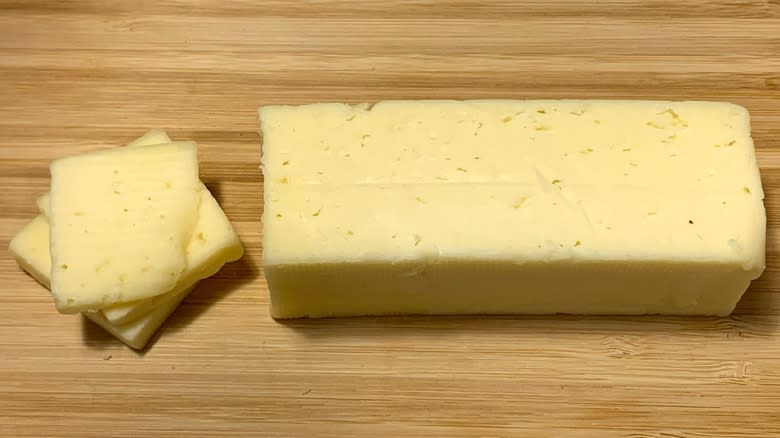
Originating in Denmark in the 1800s, Havarti is the name of the farm that developed this semi-soft cow milk cheese. Its delicious flavor is somewhere between Swiss and cheddar but on the nutty side. It took a little longer to melt than some of the other cheeses. We did not get the best consistency from the brand we bought, but it was flavorful.
Havarti cheese does compare to cheddar in one way. It is one of few cheeses that develop more flavor and complexity with aging. The longer it ages, the more it resembles cheddar, so keep this in mind when buying this cheese.
While you should be able to replace cheddar with Havarti, this cheese has a higher fat content. That can impact the texture of your recipe and may be why we didn't get the consistency we were expecting. This cheese works best for salad and fondue. It's also a welcome addition to your charcuterie board.
Muenster Cheese
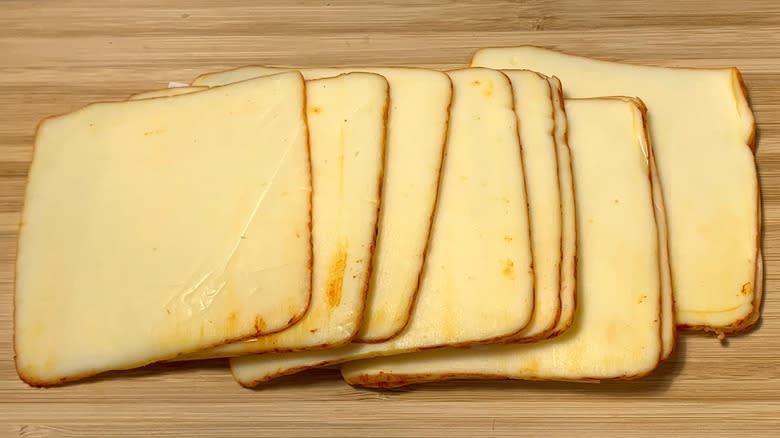
Next up is the cheese with the weird and amusing name. Muenster cheese is named for Munster in Alsace, although many believe it to be the city of the same name in Germany or the Irish province. While there is a Munster cheese, here in the U.S., we eat Muenster cheese, a slight variation on the original.
American Muenster is milder and softer than its European counterpart. It does not exactly taste like cheddar, but it is a step closer. It took a while to melt and was another variety that burned on the bottom, but it had better flavor afterward.
Muenster is a better replacement for hardier dishes. This cheese works in grilled dishes and served on a cutting board alongside red wine. Just like many cheddar recipes, it also goes well with beer. Since it's a white cheese, you'd do well to replace white cheddar in recipes such as casseroles.
Gouda
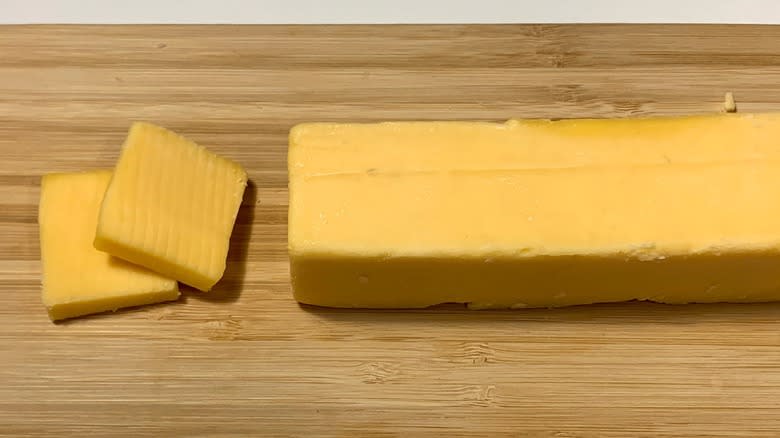
Gouda is a good substitute because, like cheddar, it is also a semi-hard cheese. What's the difference between gouda and cheddar? There are flavor differences as well as history. Named for a town in South Holland, Gouda existed in the 1400s. However, it could date back to the 13th century. Dutch gouda is different from other versions found around the world.
While gouda aging and sharpness vary, almost all varieties are milder than cheddar. Its flavor profile leans toward a sweet and nutty variety of cheese. The color depends on the length of aging: the longer, the more orange the color. Gouda is usually made from cow's milk but can come from sheep or goat's milk. It also stands out from other cheeses in one important way: After it is formed, producers soak it in brine, giving it a distinctive flavor.
Aside from a great addition to your charcuterie board -- we recommend smoked varieties -- gouda is a creative substitute for cheddar in many dishes. It took a little while to melt but it was surprisingly more like cheddar afterward, making this a great substitute. Its unique flavor is the reason we recommend you try this cheese for more traditional cheddar dishes, including mac and cheese, grilled cheese sandwiches, fondue, soups, and potato dishes. We are not fond of it on a burger. But if you'd like to try it, we recommend a sharper, aged gouda.
Daiya Dairy-Free Cheddar Slices
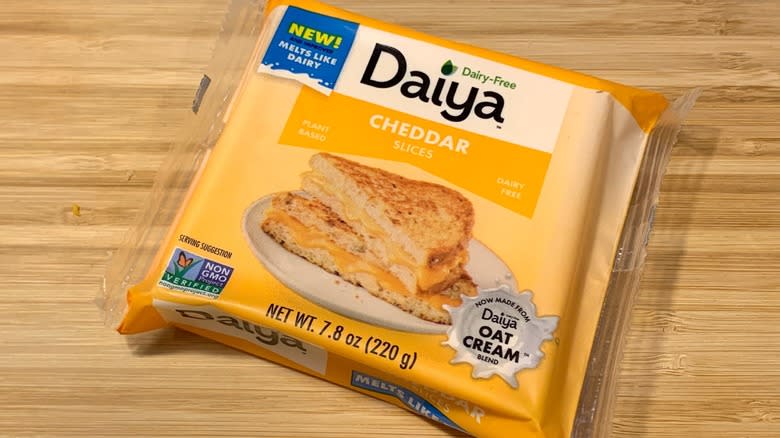
Hosting events can be challenging if you invite guests who are vegan or avoid dairy. The best hosts welcome these guests with options such as dishes made with non-dairy cheese. Daiya cheese is one of the most popular and available dairy-free cheddar brands. At first, we were hesitant to add this cheese to this article. In the past, the flavor and melting consistency was not great. However, given its recent reformulation, we thought it was time to give it another try.
We're happy to report this new Daiya formula is a much better approximation of cheddar cheese. It has a mild but salty flavor. The cheese melted slowly but was the right consistency. The new recipe just hit the shelves and is made from oat cream containing oats, pea protein, cultures, and enzymes.
The flavor was consistent whether cold or melted, so we recommend it as a one-to-one substitution for most of your cheddar cheese dishes. The taste is mild, so feel free to try one of their other flavors, like smoked gouda, if you want something stronger. We love that you can serve this to your vegan and dairy-free friends as an affordable option.
American Cheese
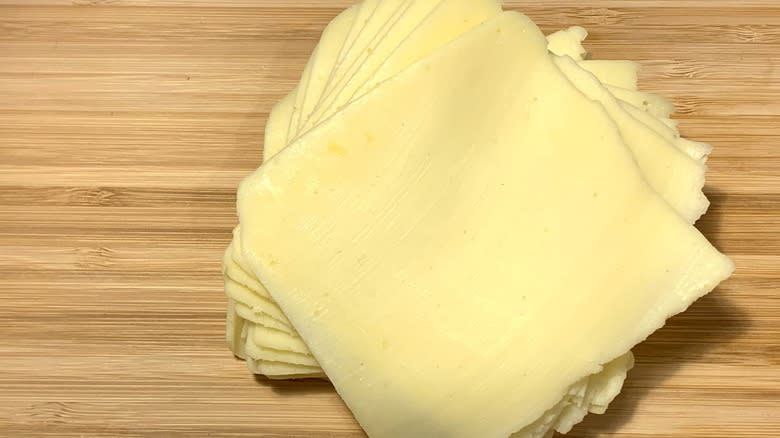
American cheese, widely available at your local deli, is a natural fit since it often comes from cheddar. However, some people may be upset that we've included processed cheese here.
Why? Here's where things get tricky. The Food and Drug Administration (FDA) states that to label a product as cheese, it has to contain 51% cheese. The rest are vegetable oils and milk proteins. We include it here because not all processed cheeses are equal. We purchased Boar's Head White American Cheddar. This processed cheese contains real milk. It was unclear from the website how much is real and how many additives there are.
The taste of American cheese imitates cheddar very well, and it melts properly. It is an easy substitute in a pinch for just about any dish, but we cannot guarantee how much real cheese it contains. The same is true of most processed brands. Therefore, we could not give it top grades. However, it is a workable substitute.
Monterey Jack
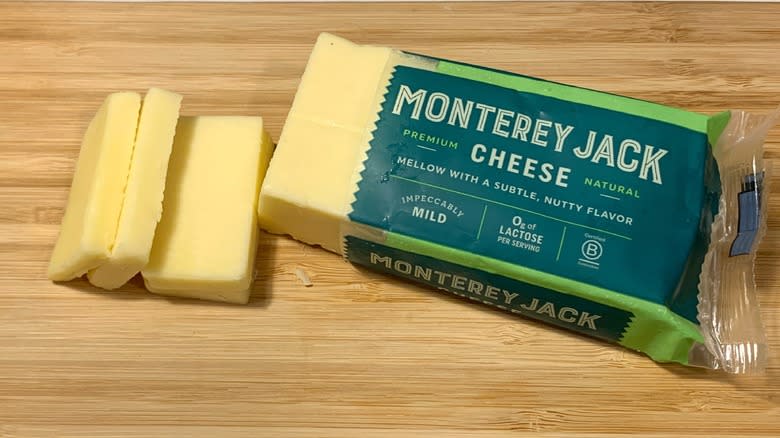
Monterey Jack hails from Monterey, California. In the 1800s, Spanish missionaries brought the cheese to the area, where it was sold by locals to support their families. Local businessman David Jack used the recipe and started producing it commercially, and the name of this variety of cheeses has stuck ever since. Jack may have given us a great cheese, but he was a ruthless businessman.
This cheese is one of our top five picks. Monterey Jack comes very close in flavor to cheddar, with slight differences. It is milder but has a richer taste. It's almost buttery. When it melted, it had a smooth and creamy consistency, making it an excellent replacement for cheddar.
That texture makes it ideal for cheesy soups, mac and cheese recipes, and melting over dishes like burritos and other bakes. It's also a good choice for cheesy dips. Remember that you can use it interchangeably with pepper jack for more kick. Monterey Jack works wonderfully in cheesy casseroles and as a filling for cheese bread recipes. We can't say enough good things about this one. Thank you, California.
Fontina Cheese
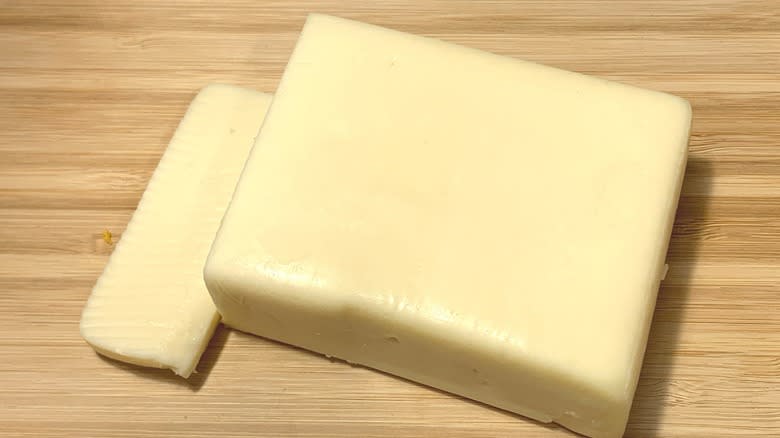
Fontina is probably a familiar name that you've seen on menus from restaurants of many different cuisines. This cheese developed in a different area of Italy: the Aosta Valley in the Italian Alps in the 12th century. It also goes by the names fontal, fontella, and fontinella. This semi-soft cheese is another cheddar replacement, especially for milder recipes. Melting this semi-soft cheese gives a smooth and creamy consistency. The flavor closely resembles a mild cheddar but with a hint of nuttiness.
Fontina is unique because it carries a PDO or Protected Designation of Origin. PDO cheeses follow strict regulations, including which cows the milk can come from. The cows graze a unique herb-flavored grass available only in the high Alps, giving fontina its unique taste. You can buy the real Fontina but you must know what to look for.
Sadly, what you see in the grocery store is not PDO Italian Alp Fontina. Production grew past Italy as many countries made their own versions of Fontina. However, this cheese is an ideal selection to replace cheddar. We recommend it for mac and cheese recipes, a standard that is tough to meet, in our opinion. That's why Fontina lands in the top two. Use a younger, creamier version for fondues and the older version for everything else, like a decadent grilled cheese sandwich.
Colby Cheese
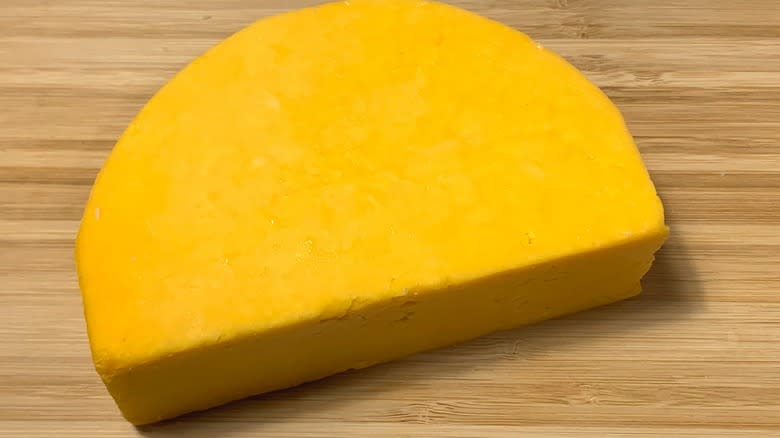
At the top of our list of recommended substitutions is Colby cheese. It's closest in taste to cheddar. But it's also decadent, smooth, and tasty enough for any occasion. Created in Colby, Wisconsin in 1885, this cheese resulted from an experiment by Joseph Steinwand, whose family owned a cheese factory. The market for his invention grew -- in a given year, Wisconsin cheesemakers now produce 45 million pounds of Colby.
Colby stands apart because it's processed differently. While typical cheeses get to the curd stage of processing, the curds are heated and separated into slabs. Instead of separating, Steinwand stirred the curds and then washed them in cold water. This process reduced the acidity of the cheese, creating a sweeter result.
While Colby is slightly milder, it's also rich and flavorful. It melts quickly to a perfect consistency and a smooth texture. It even felt like an upgrade from cheddar. We recommend Colby as the top substitute for all your cheddar recipes, from mac and cheese and cheese to soups, to comforting casseroles and Texas nachos.
Methodology
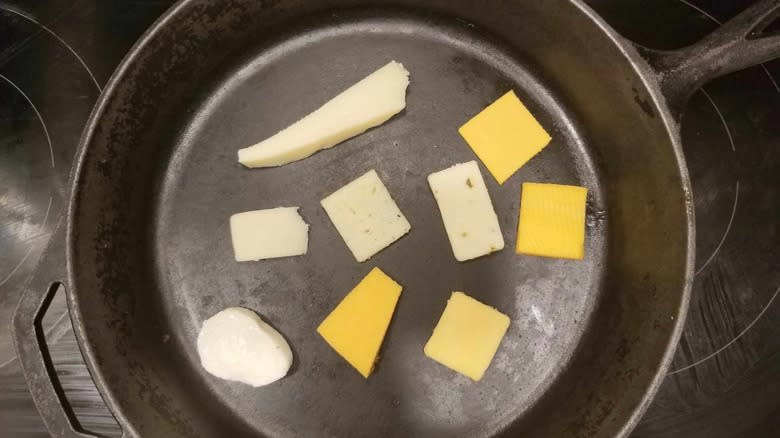
To rank the best cheddar cheese substitutes, we sought out alternative cheeses we believed would work with dishes that typically use cheddar cheese, including omelets, mac and cheese recipes, or melted toppings. These brands were widely available and affordable. We examined the taste quality to see if it closely matched cheddar and could emulate the proper taste. If it was different, we narrowed down the recipes that would fit the cheese and which would work best. Finally, we melted each cheese individually to compare texture and melting ability with cheddar. The more closely the cheese resembled cheddar cheese as a substitute in each dish, the higher rank we gave it.
That said, cheeses with distinct flavors yet similar melting qualities as cheddar help create variety in your cooking. We would not hesitate to recommend any of these selections, depending on your dish and what flavor you wish to serve.
Read the original article on Tasting Table.

